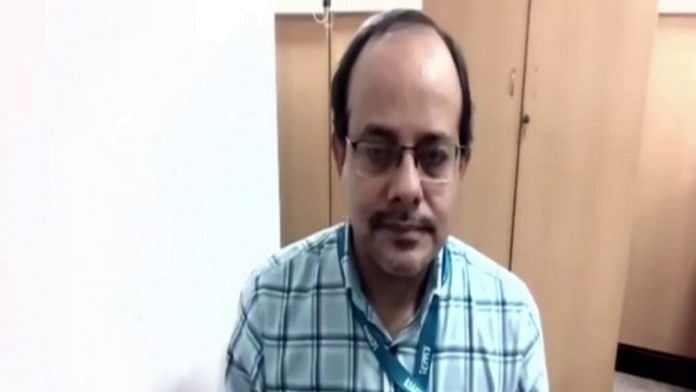New Delhi: Intermittent reports of “breakthrough infections” continue to cause alarm and raise questions about vaccine-efficacy even as India’s daily vaccination numbers rise. But. according to ICMR’s Dr Samiran Panda, such questions are misplaced as Covid vaccines currently in use do not claim to prevent infection.
“Let us understand first what is a breakthrough infection. Any infection that occurs either after the first dose or after the second dose of the vaccine is a breakthrough infection. These vaccines that we are using currently are disease-modifying vaccines, not infection-preventing vaccines,” Dr Panda, head of epidemiology and communicable diseases at the Indian Council of Medical Research (ICMR), told ThePrint.
“Their job is to prevent serious infection, hospitalisation, the need for oxygen or ventilators. Vaccines were not supposed to prevent acquisition of infection, and it is very important that people understand that so that we do not descend into a state of unnecessary panic.”
While India has categorised any infections after either dose as a breakthrough infection, usually a breakthrough infection is taken to be one that occurs 15 days after the administration of the second dose, according to trial protocol (fully vaccinated people), 15 days being the time required for the immune system to be primed.
India is currently using three vaccines — the Serum Institute of India’s Covishield, Bharat Biotech’s Covaxin, and the Russian vaccine Sputnik V that is currently available only in the private sector. Covisheld claims a vaccine efficacy of 82 per cent (two doses administered at 12 weeks interval), Covaxin claims 77.8 per cent efficacy, and Sputnik V over 91 per cent efficacy. All vaccines were tested for whether they prevent serious disease, hospitalisation, and death.
The ICMR’s stand is in line with that of the Centers for Disease Control. According to the CDC, “Vaccine breakthrough cases are expected. Covid-19 vaccines are effective and are a critical tool to bring the pandemic under control. However, no vaccines are 100 per cent effective at preventing illness in vaccinated people. There will be a small percentage of fully vaccinated people who still get sick, are hospitalised, or die from COVID-19.”
Also read: Covid vaccines for children could be available by September, Bharat Biotech & NIV say
“No surprise if thousands of breakthrough infections”
Dr Panda added that the role of vaccines is in their “drastic reduction” of hospitalisations, serious disease, and the need for oxygen or ventilators. There have been many reports of Indians being infected with the SARS-COV2 virus even after they have received the vaccines.
“You can ask me if I am surprised by the thousands of breakthrough infections reported. I am not surprised. Now that India has administered over 50 crore vaccine doses, if people do not take the precautions, if they do not adhere to Covid-appropriate behavior and feel the urge to eat out at a crowded place or do away with their mask, these infections are inevitable,” Dr Panda said.
“The real question is what is the disease progression that has happened after the vaccine. Currently, I do not have data about how many infections happened after the first dose and how many after the second dose.”
With the administration of 56,36,336 vaccine doses in the last 24 hours (as on 19 August), India’s Covid vaccination coverage has now crossed 56.64 Cr (56,64,88,433).
Explaining the reason for the lack of data about the post-vaccination infections breakup, Dr Panda said that there are separate databases on vaccinations and infections and till there is an exchange between the two it would not be possible to analyse the numbers.
The need of the hour, he said, is for people to be responsible, not just for their own sakes but also for those around them who may not always be vaccinated.
“That is why Covid-appropriate behaviour even after vaccination is so important. We need to understand that we have to keep both ourselves and those around us safe,” he said.
(Edited by Poulomi Banerjee)
Also read: Mumbai sees ‘first Delta Plus death’ — What is the new variant & where it came from






